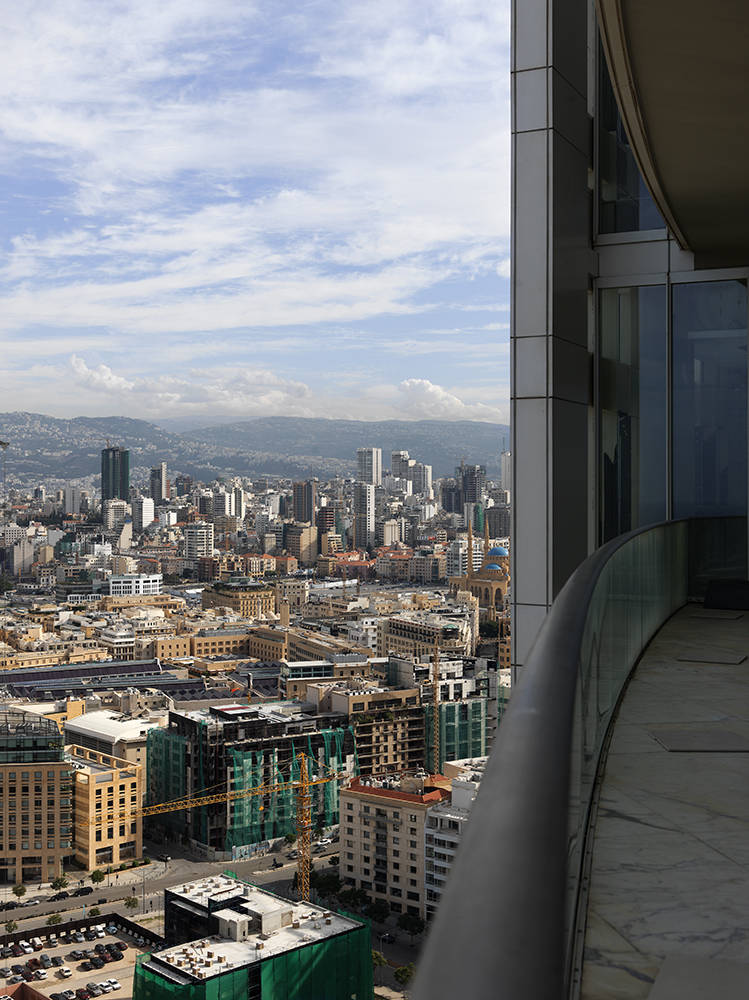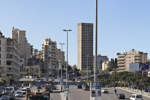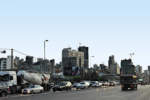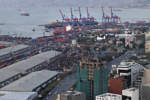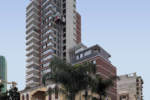“Beirut is too big to be contained!” The slogan appeared on the walls of the city in the spring of 2005, during one of the most convulsed moments in the recent history of the Levantine capital, just after the attack on Prime Minister Rafik Hariri and just before the withdrawal of the Syrian occupation troops.
Beirut is undeniably too big for it to be possible to synthesize the multifaceted reality of this “Paris of the Middle East” in a single formula; the city has grown rapidly on many thousand-years-old foundations, and where the different identifies are united first and foremost consists by the fact that they all belong to the interfaith mosaic of Lebanon.
Different models of composition, settlement and urban planning are juxtaposed in a coexistence that is synchronic in some places and dystonic in others, but never contradictory. The latent tensions existing in this fascinating complexity have often exploded in conflicts, in which the composite Lebanese identity has expressed the uncontrollable plurality of its parts with violence.
Gabriele Basilico’s photographs, taken just a year after the end of the civil war fought from 1975 to 1990, shows the intensity of the devastating fury on the part of every faction. Whole buildings shattered by bullets of every calibre, in a total guerrilla fought house by house, room by room.
In an attempt to describe the immediate effort to reconstruct, there are those who have attempted comparisons with another great city, Berlin, or with the Balkans, the other interfaith region of the Mediterranean. These parallels are legitimate, but inexact. The devastation of the German capital was the result of a folly that had originated in that city and reached full circle there, after having passed through the whole world; Beirut has on the contrary represented a clot, around which internal and regional tensions have thickened in a mixture that is difficult to understand and control.
And while the inter-ethnic conflict in the Balkans almost caught Europe by surprise, as it strove to build a Union whose constitutive goals is precisely that of a future without wars, Lebanon has never been foreign to the political stratagems of the various players in the Middle Eastern chessboard.
Twenty years later the wounds of war are still visible in Beirut: many houses still carry the scars of volleys, sometimes shot from one window to another in the same condominium, and it is indicative that two of the biggest buildings in the city are visibly marked by the conflicts. Both in disuse, the Holiday Inn and the tower of Burj El Murr hover, ominously majestic, reminding us that “Beirut is uncontainable” and that any plan or forecast must take this into account.
But Beirut is also known for its love of life. The recent phenomenon of the skybars, clubs located on the terraces of important buildings with breathtaking views, is the present-day equivalent of the movie theatres that once formed a dense network of interfaith meeting places.
This hedonistic spirit is perceptible in the real estate works in the downtown area, subtly aimed at catering to somewhat superficial pleasure-seekers, a goal that has prevailed even on concrete infrastructural requirements, and that may perhaps have indirectly contributed to the considerable delay with which the municipal administration is equipping itself with an up-to-date town plan.
Indeed, Solidere, the private agency in charge of the reconstruction of the Central District of Beirut, has renounced zoning in favour of mixed-use volumes in its master plan; this solution is more advantageous to the real estate market but also expressly aimed at creating experiences of clearly amusing urban life: shopping, participation in events, nightlife.
Angus Gavin, the manager responsible for planning at Solidere, asserts that one has not wanted to impose an overall identity, and that one has from the beginning sought to assure continuity with the atmosphere that existed in Beirut before the war. Also the decision to stake on a diffused public space based on the street (pedestrian or mixed) and to make the most of archaeological and contextual aspects of the heritage is part of an aestheticizing vision of the city, according to which concepts as functionality and sustainability become almost accessory with respect to the primary goal: to attract users and private investments. This urgency to bring life back into the centre has initially resulted in impetuous actions, and there has been no lack of nonchalant demolitions and alien architectures, a situation in evident contrast with the fundamental assumptions of Solidere, theoretically against the orderly hygienism of the French planners who razed a Medieval Beirut to the ground in the Thirties to build a Haussmanian and neo-colonialist arrangement of streets and buildings. The vicissitudes of the Souk and the Martyrs’ square, with the developments of the respective competitions and the many controversial demolitions, are examples of the difficulties encountered by Solidere in finding an adequate balance between actions and positions, both ideological and political, also due to the administrative quagmire of the old division into plots (one and the same plot was sometimes claimed by hundreds, if not thousands, of owners). Rafik Hariri, at that time Prime Minister and founder of Solidere in 1993, solved the problem in the Gordian manner, changing from fractioned to global ownership: on the basis of a new mixed public/private model, the ownership of the centre was united in a single, enormous plot with the exclusion of places of worship, governmental premises and a few other buildings. Anyone who enjoyed any kind of property rights became a proportionate shareholder of two thirds of the new agency, while the remaining third of the capital was placed on the exchange.
Solidere became, for practical purposes, the only owner of downtown Beirut, with the obligation of acting only after governmental approval of the master plan and the commitment to build infrastructures and public spaces, respecting the identity of the district, in exchange for a 75-years concession on the right to exploit the buildings, to manage the services and the permit to build and manage the new Waterfront. There has been no lack of disputes on the excessive powers granted Solidere, the absence of a real debate, the manipulation of the historical identity of the centre due to speculative interests and political conveniences and on the fears that a model of intervention of doubtful general benefits might be extended to the whole city.
The progress took a downturn with the attack on Hariri in 2005, and the fact that “the subsequent revolutionary political events have been triggered by the death of the greatest real estate tycoon in the region is no mere coincidence”, and the same is true for the popular reaction expressed by a spontaneous occupation of the Martyrs’ Square that war and scrapers had reduced to an unsettling level ground evoking a painting by De Chirico.
In the following years neither the war between Hezbollah and Israel in 2006, nor the reflux of guerrilla in May 2008, have blocked the delicate but incessant work of reconcilement and reconstruction of the country. The Arab Spring of 2011 has been followed with interest in Lebanon, but without any active involvement: the local spring had been budding for twenty years in Beirut, and nobody wanted the country to enter into another civil war. The very facility with which everyone knows that the massacre (against one’s own colleagues, neighbours or relatives) could recommence causes an instinctive attachment to life, but also a diffused inclination towards caution, if not tolerance, with respect to situations that are hard to manage politically.
An example of this is the southern district of Dahiye, which is essentially autonomously administered by the Sciite Hezbollah organization with the openly declared support of Iran. The reconstruction of this part of the city after the Israeli bombardments of 2006 has been managed without the central administration insisting too much on being involved.
Building sites and projects have grown in the last few years in this situation of tensions and vitality. But unlike other cities, whose rebirth has seen an algid moment in a specific event or building, Beirut has not played this card so far. An approved project exists for a Formula 1 racecourse in the centre, and a timid proposal as Olympic seat has been presented, but Beirut is neither the Barcelona of 1992 nor the Bilbao of the Guggenheim, nor can its public spaces be compared to those of Glasgow. The decisive incentive for private investments (seen as the best means of generating also public investment on a long term basis) has been precisely the sense of well-being emanated by the new residential towers and the prestigious visibility given to the service sector buildings by a focused upgrading of the urban space.
The foreign investors are mainly the Lebanese themselves: the million of expatriates who fled the war to increase the ranks of an existing Diaspora, and who are wealthier than the residents. Expatriate Lebanese represent 50% of the buyers of the new real estate projects; they are often shareholders of the financial companies that provide the money and partners of the large international design firms.
Moreover, the construction sector has recently been considered so safe that it is not even endangered by the outburst of a new war. The general idea is that it is much more convenient to invest money in a property, ideally a luxury tower, than to risk it on the exchange or the securities market.
Beirut is the city in this region where the price increase per square meter of new constructions has been greatest, with peaks of 400% in less than six years. One of the results has been an increase of the municipal income, whereas the government has found it harder to obtain liquid returns from the real estate boom.
On a linguistic level the initial impertinence of many of the new local architectures, above all represented by the talent of Bernard Khoury, has been attenuated with time, passing from a monotonic reflection on the war to a search for a modernity that is attentive to major international trends yet avoids to yield to the globalized attention-catching styles that characterize almost all new architectures in the nearby Arab Emirates. Also in Beirut one has programmatically followed the strategy of starchitects, but until now it has not been a matter of an uncritical consignment of the city in the saving hands of famous architects: rather, one has identified significant points, landmarks, where the famous name guarantees visibility and quality in the absence of an ampler plan. The cooperation between local firms and starchitects is very frequent and goes well beyond the normal formula of archistar-local architect, also thanks to the many Lebanese groups who have two offices, in Beirut and abroad, for instance Nabil Gholam and the L.E.FT group who have cooperated, respectively, with Ricardo Bofill and Steven Holl.
The siege on the architectural heritage (traditional Lebanese houses, but also various buildings from the Modernist period of the Fifties and Sixties) has recently become much less insistent. Paradoxically, these buildings have been preserved thanks to the civil war, that put a stop to plans of which internationalist assertiveness was making a clean slate of traditional buildings and environments; however, they seemed to be endangered once more when it seemed that the new Beirut had to eliminate traces of a past that nourished the germs of war within it.
The international financial crisis of 2008 has lowered the building fever, making it possible to reflect more attentively on the future of Beirut, beyond the duty to remember, the urgency of rebuilding and the opportunity to grow.
It remains to be seen whether, in the long term, the tightrope-walking management that has facilitated a reconstruction without visions and general plans will represent a weak point in the face of the internal and regional tensions, or whether it will on the contrary produce a completely new generic model that will allow the natural local vitality to find specific solutions to the challenges posed by the growth and the market.
Alessandro Scarnato divides his time between academic and professional activities, and between Spain and Italy. In recent years he has studied the Middle East as bridge between East and West as part of his research, which centres on the relationship between the city, politics and the cultural expressions of society.


